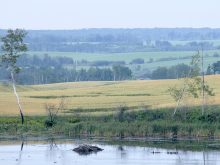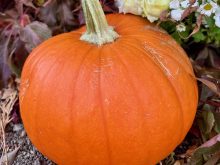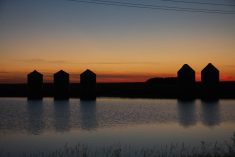The saskatoon berry harvestin the Elrose, Sask., area will be delayed this year. When it is in full swing, many of us will be out picking.
Our church is having a pie fundraiser, where one day in August we plan to make and sell pies. Saskatoon pies are one of the options, and a carload of us may head out to a U-pick.
Now we are gathering rhubarb and freezing it for the rhubarb pies. It is a first-time venture, so we’ll see how we do.
Read Also

Rural Manitoba resources slim on natural disaster planning
A study from Brandon University’s Rural Development Institute has found that many rural and small municipalities don’t have the staff or resources to make formal climate plans against natural disaster.
Saskatoon pie filling
We plan to use this large quantity saskatoon pie filling recipe.
8 quarts saskatoon berries 7.5 L
6 cups water 1.5 L
8 cups sugar 1.9 L
1/2 teaspoon salt 2 mL
1 box minute tapioca 225 g
1/4 cup lemon juice 60 mL
Put all the ingredients in a roaster. Bake in a slow oven, with the lid on, at 250 F (120 C) for 11/2 to 2 hours. Freeze in quantities you would use in one pie. Yield: Approximately 28 cups.
Source: Tessier United Church 85th Anniversary Cookbook.
Sizing down a recipe
A reader says she finds the 9 x 13 inch (22 x 33 cm) cake pan recipes make too much for her family. She doesn’t find halving the recipe in an 8 x 8 inch (20 x 20 cm) pan satisfactory.
However, that seems to be the best option. To make your recipe correct when converting to an 8 x 8 inch pan from a 9 x 13 pan, you would have to take each ingredient and multiply it by 0.547. That gets complicated when it comes to measuring some ingredients such as eggs. It is much simpler to simply cut the recipe in half and have a slightly thinner dessert.
The reverse is also true. To convert to a 9 x 13 from an 8 x 8 inch pan, double the 8 x 8 inch recipe and have a slightly thicker dessert.
I have added one-quarter to a 9 x 9 inch (22 x 22 cm) pan recipe to convert to a 9 x 13 inch (22 x 33 cm) recipe. It will have less volume but is OK for many recipes.
Safe food temperatures
I’ve heard of two instances lately where people became ill from food at a community potluck picnic. Appropriate temperatures are the most powerful tool in destroying or slowing the growth of bacteria that causes food poisoning.
Bacteria like to grow between 40 F (4 C) and 140 F (60 C). Keep foods in the refrigerator or in a cooler on ice. Once the picnic is over, don’t let food sit out. If any harmful bacteria are present, they will soon multiply in the warm temperature. The longer it sits out, the greater the number of bacteria. If you have a large dish of food, remember that the inner part will take a long time to cool and may stay at a warm temperature long enough for bacteria to grow. Put it in smaller dishes to cool more quickly.
Hot dishes should not sit at a lukewarm temperature. Soups, chili and all casseroles need to be kept hot.
Follow the “keep it hot, keep it cold” rule for a safe summertime picnic.
Meatball casserole
This is a favourite at our house and is on the list to make for workers at seeding and harvest.
13 ounces spaghetti 375 g
3 pounds lean ground beef 1.36 kg
1 1/2 cups flour 375 mL
3 onions, chopped
1/2 teaspoon garlic powder 2 mL
3 10 oz. (284 mL) cans tomato soup
11/2 10 oz. (284 mL) cans mushroom soup
2 cups milk 500 mL
1 tablespoon Worcestershire 15 mL
sauce
1 teaspoon salt 5 mL
1/2 teaspoon pepper 2 mL
Cook the spaghetti in a large pot of boiling water until tender, drain and rinse with cold water.
Shape the meat into balls, roll in flour. Place in a roaster and bake in the oven until browned or brown in oil in a heavy saucepan.
In a large saucepan or Dutch oven, sauté onions until clear and transparent. Add the rest of the ingredients. Heat until hot. Add the spaghetti and pour over the meatballs in the roaster.
Bake at 350 F (180 C) for about an hour until meatballs are cooked and the dish is bubbling hot.
Adapted from The Canadian Cookbook by Nellie Pattinson. This is my old high school home economics textbook, the one with the yellow cover. Some of you may still have this cookbook.
Celery sauté
A friend brought this to a class reunion as a cold salad dish. The following recipe is a hot vegetable dish, but it is just as tasty cold.
3 tablespoons butter 45 mL
3-4 medium stalks of celery, cut in 3 inch (7 cm) strips
4 green onions, chopped
1-4 garlic cloves, minced
1/2 cup toasted slivered almonds 125 mL
Using a heavy skillet, melt butter and add the celery. Sauté for three minutes, stirring constantly. Add the green onions and garlic. Do not overcook. The celery should be somewhat crisp. Combine with toasted almonds, sprinkling a few on top. Serves three or four.
Source: Aces, The Best of Bridge Series.
Summertime hort hints
Here’s a small sample of information found in Hort Hints III, a book about gardening on the Prairies, published by the University of Saskatchewan.
- Do not remove the tassels at the top of a corn plant. The tassels constitute the male flower and they supply the pollen. The fine, yellow dust (pollen) shed by the tassels falls onto the silk of the cob, which is the female flower. Each silk thread is attached to a kernel. If no pollen falls onto the silk, no kernel will form. Shaking the plants while the pollen is being shed can help increase pollination.
- Sunlight is important for herbs. A minimum of eight hours a day of uninterrupted sunlight is required. The more light herbs are exposed to, the better the quality and quantity harvested. Some herbs tolerate partial shade, but these are few.
- Under most conditions, harvesting rhubarb should cease at the end of July to allow food reserves to build up again in the roots and crown. Harvest by pulling the stalk or cut the stalks at ground level.
- Be careful not to damage the bark of a tree when whipper-snipping. The phloem, a plumbing layer just under the bark, is easily damaged. Damage will slow or stop the movement of nutrients and water to the roots and throughout the tree and cause the tree to stop growing.
- Peonies are often infested with ants, which are attracted by the sugars exuded by the flower buds. They are unsightly, but do not harm the peonies. Ants are not needed for peony flower development. They are there to enjoy a free lunch.
Long hours in the car and sun
Even if we rarely get sunburned in cars, low level skin damage does occur and accumulates over the years.
Clear glass screens out most ultraviolet-B radiation, the kind responsible for sunburn and tanning, but not ultraviolet-A radiation, the kind that causes skin aging and possibly melanoma.
Usually windshields are treated to block rays, but not the side and back windows. If in a car for long hours in the sun, wear long sleeves or use a sunscreen.
Windows can be professionally treated to block almost all ultraviolet rays without reducing visibility.
Source: University of California, Wellness Letter
Farm and Home Safety Contest
A farm is a dangerous place to live and work and there are always things that can be done to make a home safer. What have you done to make your farm or home safer? We would like to hear from you. Send us your innovative ideas or a story about how your safety precautions made a difference.
Please send them to TEAM Resources at The Western Producer, Box 2500, Saskatoon, Sask., S7K 2C4 or team@producer.com by Oct. 15. We will review them and present prizes for the best safety idea or steps taken.
Alma Copeland is a home economist from Elrose, Sask., and one of four columnists comprising Team Resources. Send correspondence in care of this newspaper, Box 2500, Saskatoon, Sask., S7K 2C4 or contact them at team@producer.com.














